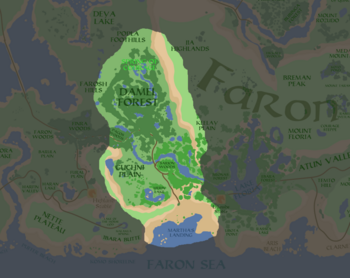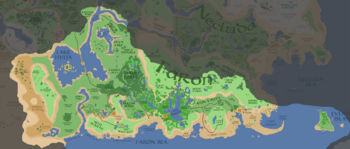Zonai Empire: Difference between revisions
No edit summary |
No edit summary |
||
| (2 intermediate revisions by the same user not shown) | |||
| Line 1: | Line 1: | ||
{{WIP}} | |||
[[category:Zonai Empire]] | |||
{{Infobox country | {{Infobox country | ||
| Line 27: | Line 31: | ||
|image_map2 = Second Zonai Empire.png | |image_map2 = Second Zonai Empire.png | ||
|alt_map2 = <!--alt text for second map--> | |alt_map2 = <!--alt text for second map--> | ||
|map_caption2 = Empire at its greatest extent | |map_caption2 = Empire at its greatest extent under [[Āśayapōkva]] | ||
|capital = [[Tanajaṭīlampaṅ]] | |capital = [[Tanajaṭīlampaṅ]] | ||
| Line 65: | Line 69: | ||
|lower_house = <!--Name of governing body's lower house, if given (e.g. "Chamber of Deputies")--> | |lower_house = <!--Name of governing body's lower house, if given (e.g. "Chamber of Deputies")--> | ||
|sovereignty_type = Sovereign entity | |sovereignty_type = Sovereign entity | ||
|sovereignty_note = All dates given relative to the founding of the Empire | |sovereignty_note = <br><small>(All dates given relative to the founding of the Empire)</small> | ||
|p1 = Tanajaṭīlampaṅ | |p1 = Tanajaṭīlampaṅ | ||
| Line 89: | Line 93: | ||
|s4 = Sheikah Civilisation | |s4 = Sheikah Civilisation | ||
|flag_s4 = | |flag_s4 = Sheikah eye.png | ||
|established_event1 = [[Tanajaṭīlampaṅ]] founded | |established_event1 = [[Tanajaṭīlampaṅ]] founded | ||
| Line 141: | Line 145: | ||
}} | }} | ||
The '''Zonai Empire''' ([[Zonai]]: ''Zōnayīlaṅka'' [ zo:n̪əji:ləŋɡə ], literally "Country of the Zonai") began as a hegemonic alliance between several of the [[Zonai (ethnic group)|Zonai]] city states in the Dracozu basin under the leadership of the Kings of [[Tanajaṭīlampaṅ]]. Despite the initial conception of the alliance as self-governing independent states, Tanajaṭīlampaṅ became dominant culturally, economically, and militarily. By the proclamation of the Empire by the Tanajaṭī king [[Akuḻnavakāṭṭa|Zōnayī Akuḻnavakāṭṭa]], the other members of the alliance had already taken subsidiary roles. | |||
The Empire engaged in wars of conquest and expanded rapidly after its formation. At its height, it controlled most of modern Hyrule south of Necluda and the Squabble River. Zonai rule has been described as ''hegemonic'' or ''indirect''; the Zonai left rulers of conquered cities and tribes in power so long as they agreed to pay semi-annual tribute and provide military forces when needed for Zonai war efforts. In return, the imperial authority offered protection and political stability, and facilitated an integrated economic network of diverse lands and peoples who had significant local autonomy. | |||
The [[Zonai religion|state religion]] of the empire was polytheistic, worshiping a diverse pantheon that included dozens of deities and often incorporated new deities from conquered peoples. Many had officially recognized cults large enough so that the deity was represented in the central temple precinct of the capital of Tanajaṭīlampaṅ. The imperial cult, specifically, was that of the goddess ''Ōḻṭona'', a protector deity shared by the Zonai, [[Lomei (ethnic group)|Lomei]], and [[Ubota (ethnic group)|Ubota]]. Peoples in conquered provinces were allowed to retain and freely continue their own religious traditions, so long as they added the imperial goddess ''Ōḻṭona'' to their local pantheons. | |||
After 4 centuries of imperial rule, the Zonai Empire began to fall into a steep decline, fueled both by internal factors such as the Lomei Uprising, a series of weak rulers, economic hardships, and by external factors such as the beginning of the Resettlement of the Surface by the Sheikah and the Hylians. 428 years after the Empire was proclaimed, it ended with the Fall of Tanajaṭīlampaṅ to the up-and-coming Lomei Kingdom. | |||
Latest revision as of 16:16, 4 May 2019
This article is incomplete because it is pending further input from participants, or it is a work-in-progress by one author. Please comment on this article's talk page to share your input, comments and questions. Note: To contribute to this article, you may need to seek help from the author(s) of this page. |
Zonai Empire Zōnayīlaṅka | |||||||||||||||||||||
|---|---|---|---|---|---|---|---|---|---|---|---|---|---|---|---|---|---|---|---|---|---|
 Location of the Zonai Empire at its proclamation | |||||||||||||||||||||
 Empire at its greatest extent under Āśayapōkva | |||||||||||||||||||||
| Capital and largest city | Tanajaṭīlampaṅ | ||||||||||||||||||||
| Official languages | Zonai | ||||||||||||||||||||
| Common languages | Palmoraean, Atunese, Florian, Keelayi, Guchni, Cora-Faronese, Baumeri, Deyani, Oseiri, Lomei, Ancient Sheikah, Proto-Hylian, Koholi | ||||||||||||||||||||
| Religion | Zonai polytheism | ||||||||||||||||||||
| Demonym(s) | Zonai | ||||||||||||||||||||
| Government | Hegemonic oligarchic monarchy | ||||||||||||||||||||
• King |
| ||||||||||||||||||||
| Sovereign entity (All dates given relative to the founding of the Empire) | |||||||||||||||||||||
| Historical era | Sky Era | ||||||||||||||||||||
• Tanajaṭīlampaṅ founded | c. -450 | ||||||||||||||||||||
• Akuḻnavakāṭṭa crowned | -8 | ||||||||||||||||||||
• Imperial Proclamation | 1 | ||||||||||||||||||||
• Civil War | 82—95 | ||||||||||||||||||||
• Stagnation of the First Century | c. 95—c. 201 | ||||||||||||||||||||
• Conquest of the Lomei | 201—220 | ||||||||||||||||||||
• Subjugation of the East | 238—c. 250 | ||||||||||||||||||||
• Āśayapōkva crowned | 251 | ||||||||||||||||||||
• Oseira War | 252—255 | ||||||||||||||||||||
• Hundred Years' Peace | 255—374 | ||||||||||||||||||||
• Māṭṭazinkata crowned | 374 | ||||||||||||||||||||
• Lomei Uprising | 377—390 | ||||||||||||||||||||
• Fall of Tanajaṭīlampaṅ | 428 | ||||||||||||||||||||
| Area | |||||||||||||||||||||
• Territorial max | 783,300 km2 (302,400 sq mi) | ||||||||||||||||||||
| Population | |||||||||||||||||||||
• Estimate | 4.5 million (at the death of Āśayapōkva) | ||||||||||||||||||||
• Density | 5.74/km2 (14.9/sq mi) | ||||||||||||||||||||
| |||||||||||||||||||||
The Zonai Empire (Zonai: Zōnayīlaṅka [ zo:n̪əji:ləŋɡə ], literally "Country of the Zonai") began as a hegemonic alliance between several of the Zonai city states in the Dracozu basin under the leadership of the Kings of Tanajaṭīlampaṅ. Despite the initial conception of the alliance as self-governing independent states, Tanajaṭīlampaṅ became dominant culturally, economically, and militarily. By the proclamation of the Empire by the Tanajaṭī king Zōnayī Akuḻnavakāṭṭa, the other members of the alliance had already taken subsidiary roles.
The Empire engaged in wars of conquest and expanded rapidly after its formation. At its height, it controlled most of modern Hyrule south of Necluda and the Squabble River. Zonai rule has been described as hegemonic or indirect; the Zonai left rulers of conquered cities and tribes in power so long as they agreed to pay semi-annual tribute and provide military forces when needed for Zonai war efforts. In return, the imperial authority offered protection and political stability, and facilitated an integrated economic network of diverse lands and peoples who had significant local autonomy.
The state religion of the empire was polytheistic, worshiping a diverse pantheon that included dozens of deities and often incorporated new deities from conquered peoples. Many had officially recognized cults large enough so that the deity was represented in the central temple precinct of the capital of Tanajaṭīlampaṅ. The imperial cult, specifically, was that of the goddess Ōḻṭona, a protector deity shared by the Zonai, Lomei, and Ubota. Peoples in conquered provinces were allowed to retain and freely continue their own religious traditions, so long as they added the imperial goddess Ōḻṭona to their local pantheons.
After 4 centuries of imperial rule, the Zonai Empire began to fall into a steep decline, fueled both by internal factors such as the Lomei Uprising, a series of weak rulers, economic hardships, and by external factors such as the beginning of the Resettlement of the Surface by the Sheikah and the Hylians. 428 years after the Empire was proclaimed, it ended with the Fall of Tanajaṭīlampaṅ to the up-and-coming Lomei Kingdom.